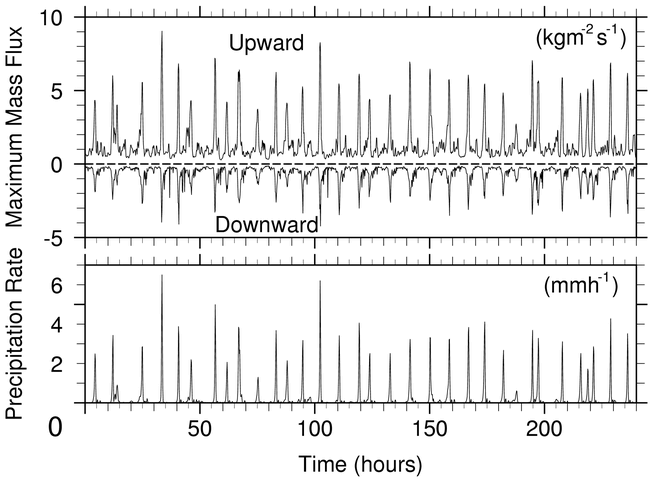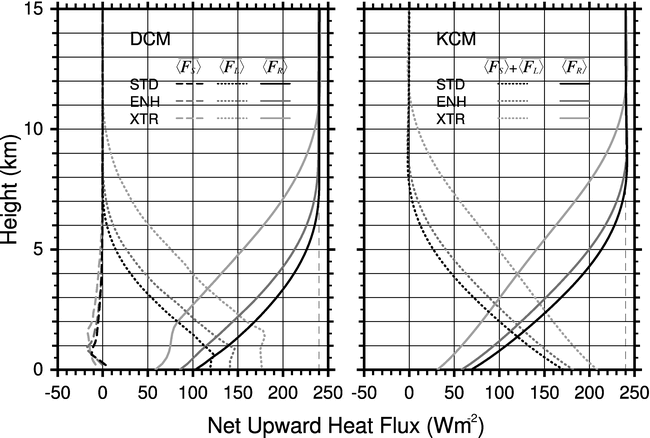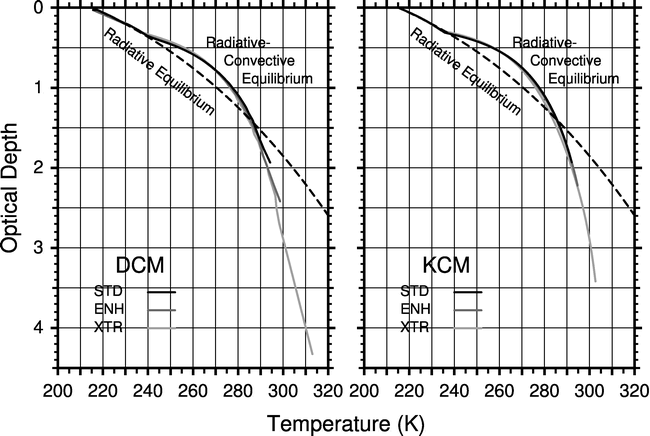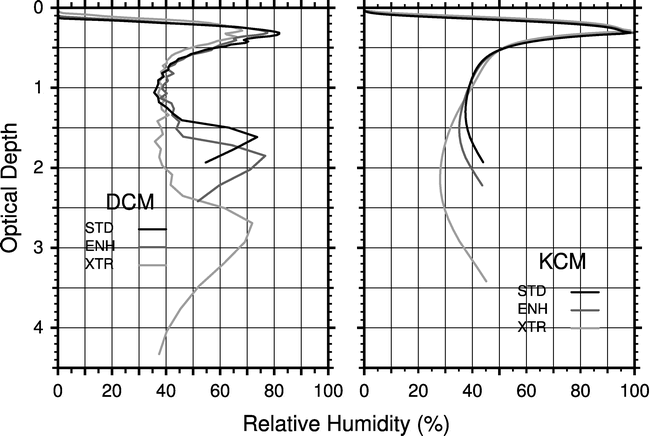
Convection-Dominant or Radiation-Dominant? < rdctheory.cloud
First, what kind of world is dominated by a convection process? For example, (not boiled) water in a pot closed by a lid being weakly heated from the bottom is dominated by a convection process. A water parcel heated from the bottom gets warmer and lighter (less dense) than the surrounding water and is pushed upwards by buoyancy. On the other hand, another water parcel forced by the upward flow is pushed aside and down. Thus, the buoyancy-forced upwelling and downwelling are constantly being maintained everywhere. Any given water parcel will always be under buoyancy-induced forcing, and there will rarely be an unforced quiet region. Such motion and structure are respectively known as Bénard convection and Bénard cells. In a pot, the water parcels with higher temperatures rise and the water parcels with lower temperatures sink, resulting in net upward heat transport. This is sensible heat transport by convection.
[NOTE]
Since there are temperature differences within the water,
heat transport by heat conduction and (infrared) radiation
is taking place within the water as well.
The pot containing the water is also in contact with the outside air,
so heat conduction and radiation are also occurring
between the water, the pot, and the ambient air.
Without this,
the equilibrated state of the pot warm-water system cannot be maintained
because the input heat energy does not go outwards.
However,
if we restrict our discussion to heat transport in the water,
convection should carry the greatest amount of heat,
and we can roughly say that the world is dominated by convection.
[NOTE]
When water boils,
convective motion becomes very intense because the thousand-fold density difference
between the liquid and gaseous phases of water is the source of buoyancy.
This situation is far removed from the conditions in the Earth's atmosphere
and is therefore excluded from our discussion here.
The Earth's atmosphere is similar to water in a pot in the way it is heated. Sunlight from the sun basically passes through the atmosphere (ignoring secondary radiation processes such as reflection and absorption by ionized substances, ozone, clouds, etc.), so it can be assumed that the surface of the Earth and the oceans are directly heated. The Earth's atmosphere is continuously heated from the bottom up, like water in a pot.
However, the Earth's atmosphere is hardly dominated by the convection process like water in a pot. Imagine what it would be like if the atmosphere were also dominated by the convective process, and if the atmosphere were moving in the same way as the water in the pot (as Bénard convection with Bénard cells). There is no stationary atmosphere, and everywhere there is a constant updraft or a downdraft forced by the convection. Where the updraft is formed, the water vapor in the air cools and condenses to form clouds, so we would have seen an extremely bizarre scene of almost evenly spaced cumulus clouds (updrafts) and blue skies (downdrafts) in a grid pattern, spreading out in all directions.
[NOTE]
The upward velocity will be larger than the downward velocity
because the latent heat of water vapor is released in the upward flow
to heat the air.
Therefore,
from the mass balance,
it is conceivable that the updraft area will be somewhat smaller
than the downdraft area.
If the Earth's atmosphere had an aspect similar to this, we would have agreed to apply Dynamical Detrainment to the transport of mass/heat/water vapor from the cumulus domains to the clear-sky regions. Most of the features of the transport could be explained from the convective motion of the cumulus clouds. Dynamical Detrainment is for the convection-dominant atmosphere. (Nevertheless, since more than half of the total area is occupied by clear sky, an explanation from the radiative process should be still necessary.)
What then is a world dominated by a radiative process? For example, the thermal equilibrium of a planet without an atmosphere is brought about only by a radiative process. The equilibrium state is determined by the balance between the incoming radiation heat provided by the star and the outgoing radiation heat emitted by the planet due to its temperature. The case of a planet with a very thin atmosphere would be similar. Most of the heat transport should take place by the radiative process, as convection of the atmosphere is not sufficient to provide large heat transport. As a planet's atmosphere becomes optically thicker, the heat transport will shift from radiation to convection. In an optically very thick atmosphere, which is opaque to radiation, on the other hand, heat cannot be transported by the radiative process in the atmosphere and must be transported by convection, in which the atmosphere itself is in motion. Under such circumstances, the atmosphere may move in the same way as water in a pot.
Look up in the sky ... Most of you will see blue skies. Some people see stratus clouds spreading out, but they are not cumulus clouds (of strong updrafts). In any case, only a few people are under a cumulus cloud at the moment. This means that the time and space in which convection takes place is very few. First of all, the area occupied by cumulus clouds (diameter of a few kilometers) is extremely small compared to the clear-sky area outside the cumulus clouds (diameter of several tens of kilometers). Furthermore, on average, a cumulus event has a duration of one hour and intervals of ten hours or more. During the intervals when cumulus clouds do not develop, a quiet state prevails, in which the radiative process continues to occur. You would agree that the motion of Earth's atmosphere seems quite different from the that of water in a pot. Under such a condition, radiative process must be primary in heat transport and convective process must be playing only a secondary role, as for the planet with a thin atmosphere. This raises the question whether our strong impression of convection is only influenced by meteorological phenomena such as strong precipitation associated with cumulus clouds.
[NOTE]
Did you notice that there is only one vertical region
in the Earth's atmosphere where convection is dominant?
That's right, the CBL.
The region near the surface is optically deep
(with high density of material interacting with radiation)
and cannot carry enough heat outward from the planet by radiative processes.
Therefore, convective motion is constantly occurring,
carrying the heat vertically upward.
Bénard cells,
the typical structure of convective dominance,
are also often observed in the CBL.
If the atmosphere were optically thin enough
for radiative processes to carry enough heat,
the CBL might not exist.
That is,
most of the heat would be transported by radiative processes,
and if necessary,
intermittent,
compensating cumulus convection might develop directly from near the surface.
On the other hand,
if the atmosphere were optically very thick,
radiative processes might not be able to transport enough heat,
and the CBL might develop up to the tropopause height,
where convection would dominat.
The Earth's atmosphere has characteristics somewhere in between.
If we restrict our discussion to the atmosphere above CBL,
however,
we can say that it is a radiation-dominated world.

This basic feature was reproduced also in our experiments using DCM (Dynamical Convection Model). DCM is a numerical model that explicitly treats cumulus convection in a vertical 2D atmosphere and introduces a simplified radiation process of gray atmosphere. The assumption of the gray atmosphere (with single longwave radiation wavelength) may lead to a somewhat different situation compared to the real atmosphere (with many longwave radiation wavelengths), but has the advantage that the optical thickness can be easily defined, facilitating interpretation based on radiative process. After giving realistic thermodynamical properties of the Earth's atmosphere, the radiative property parameters were determined so as to provide an average lower end-atmospheric temperature (approximately 15 °C) and an tropopause height (approximately 10 km). Long-time (larger than 100 days) integration of the DCM yields an equilibrium state that closely resembles the real Earth's atmosphere. At the lower end of the atmosphere, a CBL (Convective Boundary Layer) with a few km depth is constantly maintained by convections, from which cumulus convection develops about once every 10 hours, with a duration of about one hour.
[NOTE]
The maximum upward mass flux shown in Fig. D-1 occurs over a width of one or two grids,
while the grids with the maximum downward mass flux are on either side of this updraft,
and the grids around it also have downdrafts.
This means that
the upward and downward mass fluxes,
which are dynamically forced by convection,
almost cancel each other out
in the immediate vicinity of the cumulus cloud.

Specifically speaking, the following three types of heat fluxes carry heat in the DCM atmosphere:
In the equilibrium state obtained by DCM, the sum of these three fluxes at any altitude results in a heat flux that is opposite in direction (upward) and has the same constant absolute value as the solar radiation heat flux (downward), indicating that the solar radiation heat flux and the three heat fluxes bring the atmosphere to thermal equilibrium (Fig. D-2). The sensible heat flux, which can be locally large, is almost balanced between the upward and downward regions and cancels each other out, so that it makes almost no real contribution to heat transport. The net upward heat transport in the atmosphere is contributed by the two substantial heat transports: the latent heat flux and the planetary radiation flux.
In the lower atmosphere, the latent heat flux carries the heat upward, but its contribution is replaced by the radiation flux with altitude, and at the top of the troposphere, the radiation flux does all the heat transport. Judging from the vertical profile of the heat energy flux, the Earth's atmosphere is in a state of radiative-convective equilibrium, in which both radiative and convective (latent heat) processes make non-negligible contributions.
The characteristics of the distributions of temperature and humidities determined by these heat fluxes are shown below with their profiles versus optical depth.
Plotting mean temperature profiles for different warming conditions against the optical thickness on the vertical axis,

we see that they all agree, not only on the radiative equilibrium curve (above the tropopause), but also on the radiative-convective equilibrium curve (in the troposphere). The difference appears only in the large depth to which the radiative-convective equilibrium curve extends. In the standard condition (STD), it extends only to an optically shallow depth, but in warming conditions (ENH and XTR) it extends to deeper depths. In addition, in the vertical region of the CBL, these curves are slightly displaced from each other. This is because only the optically deep regions, such as those corresponding to the CBL, are dominated by convection rather than radiation process.
Because the RDC transports water vapor directly from the flank of cumulus cloud to clear area, the troposphere is not as desiccated as that chimney-type convection (in which outflows occur only near the top of them) would expect, but a constant relative humidity in the vertical direction is maintained to guarantee a minimum value. The constant relative humidity value is independent of warming conditions (the amounts of the non-condensable greenhouse gas in the atmosphere).
Plotting mean relative humidity profiles for different warming conditions against the optical thickness on the vertical axis,

we see again that they agree in the upper troposphere. The differences appear only in the lower troposphere including the CBL. This means that the lower troposphere, such as the CBL, is mainly dominated by convective process, while the upper troposphere is dominated by radiative process. Considering that air and water vapor in it are supplied by the subsidence flow associated with RDC, the constant minimum relative humidity in the troposphere is mainly determined by radiative process.
It is also interesting to note that this vertical region of the constant minimum relative humidity coincides with the region of optical thickness 1. The altitudes of the optical thickness 1 interact most efficiently with radiative process. (An optical thickness that is too shallow allows the radiation flux to simply pass through, while an optical thickness that is too deep does not allow the radiation flux to reach.)
[NOTE]
We have mentioned here and there the result
that the RDC maintains a constant relative humidity in the vertical direction.
We are referring to the fact that,
although
the relative humidity in the upper and lower troposphere takes on large values
due to the influences of the tropopause and CBL, respectively,
in the middle troposphere between them
it remains constant in the vertical direction.
In Fig. D-4, for the different warming senarios of STD, ENH, and XTR,
the mean relative humidity h is constant about 35%-40% in the vertical direction
for optical thicknesses τ of 0.7 < τ < 1.4,
0.7 < τ < 1.5,
and 0.6 < τ < 2.3,
respectively.
[NOTE]
Only the relative humidity of KCM for the XTR case becomes smaller
than the other results in the lower troposphere.
This is due to the simplified gray-radiation process.
In the single-wavelength radiation process,
the cooling rate maximum appears concentrated at a certain altitude
in the optically thickened atmosphere.
This leads to a twisted RDC flow from outside to inside the cumulus,
which makes the lower troposphere unrealistically drier.
Convection-Dominant or Radiation-Dominant? < rdctheory.cloud
Exhibited on 2023/01/18
Last updated on 2024/12/11
Copyright(C)2022-2023 jos <jos@kaleidoscheme.com> All rights reserved.